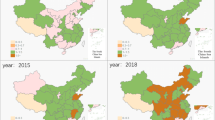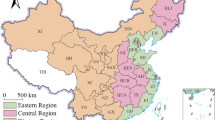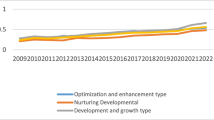Abstract
Inclusive green growth (IGG) based on coordinating the society, economy, and environment is a new way to reach sustainable development. However, there is a lack of relevant research in developing countries. To bridge this gap, based on a comprehensive index that includes economy, social, and environment, this study evaluates the urban inclusive green growth index (IGGI) of 282 in China from 2003 to 2020 and analyzes the spatiotemporal dynamics and regional differences. Moreover, the spatial Durbin model is employed to explore the plausible influencing factors of urban IGGI in China. The main results show an increasing trend of IGGI in Chinese cities and imbalanced spatiotemporal dynamics. Furthermore, the econometric regress results show that upgrade of industrial structure, opening up, human capital, and urban innovation have significant positive impact on urban IGGI, while the administrative capacity of the government and urban industrialization show negative impact on urban IGGI; human capital not only affects the local IGGI but also has significant spatial spillover effects to the surrounding cities. This finding provides new evidence for China to achieve its 2030 sustainable development goals and sheds lights on how policy can be improved to boost IGGI levels and achieve carbon neutrality in 2060.







Similar content being viewed by others
Data availability
The datasets used and/or analyzed during the current study are available from the corresponding author on reasonable request.
Notes
The Rio 2012, Rio+20, also known as United Nations Conference on Sustainable Development (UNCSD).
References
Abid N, Wu J, Ahmad F et al (2020) Incorporating environmental pollution and human development in the energy-growth nexus: a novel long run investigation for Pakistan. Int J Environ Res Public Health 17(14):5154
Abid N, Ikram M, Wu J, Ferasso M (2021) Towards environmental sustainability: exploring the nexus among ISO 14001, governance indicators and green economy in Pakistan. Sustain Prod Consum 27:653–666
Abid N, Ceci F, Ikram M (2022) Green growth and sustainable development: dynamic linkage between technological innovation, ISO 14001, and environmental challenges. Environ Sci Pollut Res 29(17):25428–25447
Adams S, Boateng E, Acheampong AO (2020) Transport energy consumption and environmental quality: does urbanization matter? Sci Total Environ 744:140617
Ali R, Bukhsh K, Yasin MA (2019) Impact of urbanization on CO2 emissions in emerging economy: evidence from Pakistan. Sustain Cities Soc 48:101553
Ali-Toudert F, Ji LM (2017) Modeling and measuring urban sustainability in multi-criteria based systems—a challenging issue. Ecol Indic 73:597–611
Anselin L, Cho WKT (2002) Spatial effects and ecological inference. Polit Anal 10(3):276–297
Araar A (2008) On the decomposition of polarization indices: illustrations with Chinese and Nigerian household surveys. Soc Sci Electron 8(806):117–126
Armeanu D, Vintil G, Andrei JV et al (2018) Exploring the link between environmental pollution and economic growth in EU-28 countries: is there an environmental Kuznets curve? PLoS One 13(22):102259
Bank TW (2018) Measuring inclusive green growth
Berkhout E, Bouma J, Terzidis N, Voors M (2017) Supporting local institutions for inclusive green growth: developing an evidence gap map. NJAS: Wageningen J Life Sci 84:51–71 S1573521417300192
Bibri SE, Krogstie J (2017) Smart sustainable cities of the future: an extensive interdisciplinary literature review. Sustain Cities Soc 31:183–212
Brand U, Boos T, Brad A (2017) Degrowth and post-extractivism: two debates with suggestions for the inclusive development framework. Curr Opin Environ Sustain 2017:36–41
Chen Y, Zhang DN (2020) Evaluation of city sustainability using multi-criteria decision-making considering interaction among criteria in Liaoning province China. Sustain Cities Soc 59:102211
Chen M, Liu H, Sun Y, Economics SO (2016) Research on the spatial differences and distributional dynamic evolution of financial development of five megalopolises from 2003 to 2013 in China. J Quant Techn Econ 7(16):130–144 (in Chinese)
Cheng DY, Xue QY, Hubacek K, Fan JL, Shan YL, Zhou Y, Coffman D, Managi S, Zhang X (2021) Inclusive wealth index measuring sustainable development potentials for Chinese cities. Glob Environ Chang 72:102417
Close CL (2020) “The economy” as if people mattered: revisiting critiques of economic growth in a time of crisis. Globalizations 2:1–18
Cui H, Wang H, Zhao Q (2019) Which factors stimulate industrial green total factor productivity growth rate in China? An industrial aspect. Greenhouse Gases: SciTechnol 9(12):505–518. https://doi.org/10.1002/ghg.1874
Dagum C (1997) A new approach to the decomposition of the Gini income inequality ratio. Empir Econ 22(4):515–531
Danish, Wang Z (2019) Investigation of the ecological footprint's driving factors: what we learn from the experience of emerging economies. Sustain Cities Soc 49:101626
Du K, Cheng Y, Yao X (2021) Environmental regulation, green technology innovation, and industrial structure upgrading: the road to the green transformation of Chinese cities. Energy Econ 98:105247
Elhorst JP (2010) Applied spatial econometrics: raising the bar. Spat Econ Anal 5(1):9–28
Fu T (2021) What provides the micro-foundation of monetary policies in the absence of mature economic institutions? Int Rev Financ Anal 73(11):101615
Ghaffarpasand O, Talaie MR, Ahmadikia H, Talaiekhozani A, Majidi S (2021) How does unsustainable urbanization affect driving behavior and vehicular emissions? Evidence from Iran. Sustain Cities Soc 72(1):103065
Grant KA, Chuang S (2012) An aggregating approach to ranking cities for knowledge-based development. Int J Knowl Based Dev 3(1):17–34
Guo L, Qu Y, Wu C, Gui S (2018) Evaluating green growth practices: empirical evidence from China. Sustain Dev 26(3):302–319
Halkos G, Moll de Alba J, Todorov V (2021) Economies’ inclusive and green industrial performance: an evidence based proposed index. J Clean Prod 279:123516. https://doi.org/10.1016/j.jclepro.2020.123516
He Q, Du J (2021) The impact of urban land misallocation on inclusive green growth efficiency. Environ Sci Pollut Res 29:3575–3586
Herrero C, Pineda J, Villar A, Zambrano E (2020) Tracking progress towards accessible, green and efficient energy: the Inclusive Green Energy index. Appl Energy 279:115691
Heshmati A, Rashidghalam M (2021) Assessment of the urban circular economy in Sweden. J Clean Prod 310(4):127475
Hong T, Yu N, Mao Z, Zhang S (2021) Government-driven urbanisation and its impact on regional economic growth in China. Cities 117(2):103299
Hu W, Wang R (2019) Which Chinese cities are more inclusive and why? Cities 86:51–61
Hu YJ, Wang FH, Guin C, Zhu HJ (2018) A spatio-temporal kernel density estimation framework for predictive crime hotspot mapping and evaluation. Appl Geogr 99:89–97
Huang H, Wang F, Song M et al (2021) Green innovations for sustainable development of China: analysis based on the nested spatial panel models. Technol Soc 65(4):101593
Huo T, Li X, Cai WG, Zuo J, Wei H (2020) Exploring the impact of urbanization on urban building carbon emissions in China: evidence from a provincial panel data model. Sustain Cit Soc 56:102068
Ikeda S, Managi S (2019) Future inclusive wealth and human well-being in regional Japan: projections of sustainability indices based on shared socioeconomic pathways. Sustain Sci 14(1):147–158. https://doi.org/10.1007/s11625-018-0589-7
Jiang L, Zuo QT, Ma JX, Zhang ZZ (2021) Evaluation and prediction of the level of high-quality development: a case study of the Yellow River Basin. China Ecol Indicat 10(129):107994
Kassouri Y (2021) Monitoring the spatial spillover effects of urbanization on water, built-up land and ecological footprints in sub-Saharan Africa. J Environ Manag 15(300):113690
Kaur P (2021) Spatial spillover of product innovation in the manufacturing sector: evidence from India. J Knowl Econ 7:173–188
Kaur H, Garg P (2019) Urban sustainability assessment tools: a review. J Clean Prod 210:146–158
Kissinger M, Stossel Z (2021) An integrated, multi-scale approach for modelling urban metabolism changes as a means for assessing urban sustainability. Sustain Cities Soc 67(1):102695
Kouton J (2020) The impact of renewable energy consumption on inclusive growth: panel data analysis in 44 African countries. Econ Chang Restruct 54(1):145–170
Kumar P (2017) Innovative tools and new metrics for inclusive green economy. Curr Opin Environ Sustain 24:47–51
Li YX, Abdel-Aty M, Yuan JH, Cheng ZY, Lu J (2020) Analyzing traffic violation behavior at urban intersections: a spatio-temporal kernel density estimation approach using automated enforcement system data. Accid Anal Prev 141:105509
Liu W, Zhan JY, Zhao F, Wei XQ, Zhang F (2021a) Exploring the coupling relationship between urbanization and energy eco-efficiency: a case study of 281 prefecture-level cities in China. Sustain Cities Soc 11(64):102563
Liu Z, Li R, Zhang XT, Shen Y, Yang L, Zhang X (2021b) Inclusive green growth and regional disparities: evidence from China. Sustainability 13:11651
Mccartney M, Brunner J (2020) Improved water management is central to solving the water-energy-food trilemma in Lao PDR. Int J Water Resources Dev 4:1–21
Ofori IK, Asongu S (2021) ICT Diffusion Foreign Direct Investment and Inclusive Growth in Sub-Saharan Africa. SSRN Electronic Journal. https://doi.org/10.2139/ssrn.3846828
Ojha VP, Pohit S, Ghosh J (2020) Recycling carbon tax for inclusive green growth: a CGE analysis of India. Energy Policy 144:111708
Org Z (2012) Inclusive green growth: the pathway to sustainable development. World Bank.
Oyinlola MA, Adedeji A (2017) Human capital, financial sector development and inclusive growth in sub-Saharan Africa. Econ Chang Restruct 52:43–66
Oyinlola MA, Adedeji AA, Bolarinwa MO (2020) Exploring the nexus among natural resource rents, human capital and industrial development in the SSA region. Econ Chang Restruct 53(1):87–111. https://doi.org/10.1007/s10644-018-09243-3
Paiho S, Mäki E, Wessberg N, Paavola M, Tuominen P, Antikainen M, Heikkilä J, Rozado CA, Jung N (2020) Towards circular cities—conceptualizing core aspects. Sustain Cities Soc 59:Article 102143
Pan W, Wang J, Lu Z, Liu YS, Li YR (2021) High-quality development in China: measurement system, spatial pattern, and improvement paths. Habit Int 21(118):102458
Peng X (2020) Strategic interaction of environmental regulation and green productivity growth in China: green innovation or pollution refuge? Sci Total Environ 732:139200
Peng W, Yin Y, Kuang C, Wen Z, Kuang J (2021) Spatial spillover effect of green innovation on economic development quality in China: evidence from a panel data of 270 prefecture-level and above cities. Sustain Cities Soc 69(2):102863
Rathee G, Iqbal R, Jaglan N, Lal SP, Menon VG (2020) A trust analysis scheme for vehicular networks within IOT-oriented green city. Environ Technol Innov 20(1):101144
Ruan FL, Yan L, Wang D (2020) The complexity for the resource-based cities in China on creating sustainable development. Cities 97:102571
Shahbaz M, Sbia R, Hamdi H, Ozturk I (2014) Economic growth, electricity consumption, urbanization and environmental degradation relationship in United Arab Emirates. Ecol Indic 45(Oct.):622–631
Sharifi A (2020) Urban sustainability assessment: an overview and bibliometric analysis. Ecol Indic 21(121):77–86
Soma K, van den Burg SWK, Hoefnagel EWJ, Stuiver M, van der Heide CM (2018) Social innovation — a future pathway for blue growth? Mar Policy 87(Jan.):363–370
Spash CL (2020) “The economy” as if people mattered: revisiting critiques of economic growth in a time of crisis. Globalizations 2:1–18
Stiglitz JE (2016) Inequality and economic growth. Polit Q 86(8):134–155
Sulemana I, Nketiah-Amponsah EA, Codjoe E, Andoh JAN (2019) Urbanization and income inequality in sub-Saharan Africa. Sustain Cities Soc 48:101544–101544
Sun Y, Ding W, Yang Z, Yang G, Du J (2020) Measuring China’s regional inclusive green growth. Sci Total Environ 713(Apr.15):136367.1–136367.10
Tan Y, Xu H, Zhang X (2016) Sustainable urbanization in China: a comprehensive literature review. Cities 55:82–93. S0264275116300622. https://doi.org/10.1016/j.cities.2016.04.002
Tian Y, Wang R, Liu L, Ren Y (2021) A spatial effect study on financial agglomeration promoting the green development of urban agglomerations. Sustain Cities Soc 70:102900
United Nations (2019) World Urbanization Prospects: The 2018 Revision Report. New York
Wang KF, Zhao XK, Peng BY, Zeng YM (2020a) Spatio-temporal pattern and driving factors of municipal solid waste generation in China: new evidence from exploratory spatial data analysis and dynamic spatial models. J Clean Prod 270:121794
Wang CH, Steinfeld E, Maisel JL, Kang B (2021a) Is your smart city inclusive? Evaluating proposals from the U.S. Department of Transportation’s smart city challenge. Sustain Cities Soc 74(2):103148
Wang KH, Umar M, Akram R, Caglar E (2021b) Is technological innovation making world “greener”? An evidence from changing growth story of China. Technol Forecast Soc Chang 165:120516
Wellmann T, Schug F, Haase D, Pflugmacher D, Linden S (2020) Green growth? On the relation between population density, land use and vegetation cover fractions in a city using a 30-years Landsat time series. Landsc Urban Plan 202(10):164–175
World Bank (2012) World Bank Inclusive Green Growth: the pathway to sustainable development. World Bank Publications
Xu Z, Chau SN, Chen X et al (2020) Assessing progress towards sustainable development over space and time. Nature 577(7788):74–78
Yang ZS (2019) Sustainability of urban development with population decline in different policy scenarios: a case study of northeast China. Sustainability 11:6442
Yang ZS, Yang H, Wang H (2020) Evaluating urban sustainability under different development pathways: a case study of the Beijing-Tianjin-Hebei region — ScienceDirect. Sustain Cities Soc 61(1):102226
Zhang BQ, Nozowa W, Managi S (2021a) Spatial inequality of inclusive wealth in China and Japan. Econ Anal Policy 21(71):164–178
Zhang X, Guo W, BilalBashir M (2021b) Inclusive green growth and development of the high-quality tourism industry in China: the dependence on imports. Sustain Prod Consum 22(29):57–78
Zhong J, Liu J, Jiao L, Lian X, Xu Z, Zhou Z (2021) Assessing the comprehensive impacts of different urbanization process on vegetation net primary productivity in Wuhan, China, from 1990 to 2020. Sustain Cities Soc 11(75):103295
Acknowledgements
The authors are grateful to the editor and anonymous reviewers for their insightful and helpful comments.
Funding
This work was supported by the National Key R&D Program of China (Grant no. 2018YFA0703900) and the Major Project of National Social Science Foundation of China (Grant no. 19ZDA091).
Author information
Authors and Affiliations
Contributions
Shuangshuang Fan focuses on the conceptualization, methodology, software, and writing—original draft. Hongyun Huang focuses on conceptualization, methodology, software, and investigation. William Mbanyele focuses on supervision, reviewing, and editing. Zihao Guo focuses on conceptualization, supervision, and funding acquisition. Chenxi Zhang focuses on reviewing and editing.
Corresponding author
Ethics declarations
Ethics approval and consent to participate
Not applicable.
Consent for publication
Not applicable.
Conflict of interest
The authors declare no competing interests.
Additional information
Responsible Editor: Eyup Dogan
Publisher’s note
Springer Nature remains neutral with regard to jurisdictional claims in published maps and institutional affiliations.
Appendices
Appendix 1. The calculation process of the urban economic resilience
The process to calculate urban economic resilience in the main manuscript is as follows:
where \({Re}{sis}_i^t\) denotes the relative urban economic resilience of city i in year t; ∆Yi represents the actual economic condition (GDP) of the city i; and ∆E means the predicted economy condition of the city, which is based on the overall region’s economic resilience condition.
where \({Y}_i^t\) and \({Y}_i^{t-k}\) denote the quantitative indicator of city or region i in the year t and the year t − k, while \({Y}_r^t\) and \({Y}_r^{t-k}\) mean the quantitative indicator of economic resilience of overall nation or the region in the year t and the year t − k.
Formulas (1)–(3) can be further merged as
To compare all of the cities, we could conduct the centralized treatment for the results as follow:
where n means the total amount of cities and (−1)p denotes the coefficient of correction, p = 0.
We could compare the urban economic resilience of each city by Ri, if Ri > 0, means the economic resilience of city i is better than the overall region, while if Ri < 0, means the economic resilience of city i is worse than the overall region.
Appendix 2 The results of robustness check
Rights and permissions
Springer Nature or its licensor holds exclusive rights to this article under a publishing agreement with the author(s) or other rightsholder(s); author self-archiving of the accepted manuscript version of this article is solely governed by the terms of such publishing agreement and applicable law.
About this article
Cite this article
Fan, S., Huang, H., Mbanyele, W. et al. Inclusive green growth for sustainable development of cities in China: spatiotemporal differences and influencing factors. Environ Sci Pollut Res 30, 11025–11045 (2023). https://doi.org/10.1007/s11356-022-22697-3
Received:
Accepted:
Published:
Issue Date:
DOI: https://doi.org/10.1007/s11356-022-22697-3




